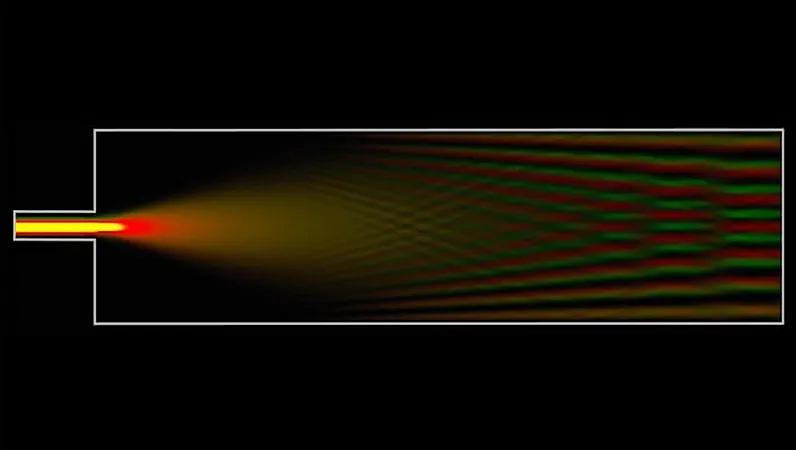
Miniaturized Spectrometer Outperforms Giant Counterparts—A Leap for Astrobiology and Medical Diagnostics!
2024-11-24
Author: Liam
In the realm of astrobiology, the quest to explore distant planets and their ecosystems is gaining unprecedented momentum. As we send increasingly sophisticated probes to the farthest reaches of our solar system, the demand for advanced analytics conducted on-site—without direct human intervention—has never been more crucial. The ability to unravel the complexities of alien ecologies and their inhabitants will determine the success of future missions. A groundbreaking development in imaging technology is paving the way for these capabilities.
Researchers at UC Santa Cruz are tackling the challenge of creating ultra-small yet powerful spectrometers, devices historically known for their large size and astronomical costs. Spectrometers work by breaking down light waves into their constituent colors, or spectra, providing invaluable information about the chemical makeup of distant stars or even biological markers on distant planets.
Revolutionary Device: Small Size, High Power
Led by the interdisciplinary team of Professor Holger Schmidt from Electrical and Computer Engineering and Professor Kevin Bundy from Astronomy and Astrophysics, the researchers have engineered a miniaturized spectrometer that offers a remarkable wavelength resolution of 0.05 nanometers—approximately 1.6 million times narrower than a human hair. This astonishing capability matches that of spectrometers that are 1,000 times larger and exponentially more expensive.
“This level of performance is almost indistinguishable from much larger, costly devices,” Schmidt explained. “It’s a noteworthy achievement that could change the landscape of spectroscopy.”
Efficient Manufacturing: Tackling Traditional Barriers
Historically, the miniaturization of spectrometers has proved difficult, often resulting in performance compromises or complex, costly manufacturing processes that involve precise nanofabrication. However, UC Santa Cruz's solution uses a sophisticated waveguide mounted on a chip that directs light into particular patterns based on color. This technique allows the team to achieve high performance while simplifying the production process, reducing what typically takes weeks down to just hours.
Furthermore, the device employs machine learning algorithms capable of interpreting light patterns without requiring highly accurate inputs, making the analysis both efficient and adaptable. This significant improvement opens doors for researchers to fabricate these devices easily and customize them for specific applications.
Astronomy and Beyond: The Future of Exploration
The implications for astronomy are profound. With their relatively low cost, these spectrometers allow astronomers to tailor instruments precisely to their research needs, which has historically been improbable with traditional million-dollar equipment. The UC Santa Cruz team is already collaborating with the UC-operated Lick Observatory, aiming to harness their technology to analyze light from stars and study various astronomical phenomena, including atmospheric compositions of exoplanets and the properties of dark matter in remote galaxies.
But the application of this cutting-edge technology doesn't end with astronomy. Its success with fluorescence detection positions it as a promising tool for medical diagnostics, including cancer screening and infectious disease detection. Future developments may extend into Raman scattering analysis, which can identify unique molecules in various environments, from human body fluids to potentially hazardous pollutants in the environment.
A Revolutionary Step Forward
This pioneering research exemplifies a transformative leap for both astrobiology and health diagnostics. The team's ability to integrate multiple waveguides into a single spectrometer enhances its capability, paving the way toward the possibility of using hundreds of chips simultaneously. The vision of reaching higher spectral resolutions and sensitivity is already on the horizon, promising a future where accurate analysis becomes more accessible and tailored to the needs of researchers across a multitude of fields.
As we expand our frontiers in space exploration and health science, this innovative spectrometer signals a significant advancement that could redefine our understanding of the universe and improve our ability to respond to medical challenges on Earth. The future is bright—and it’s only getting brighter!









 Brasil (PT)
Brasil (PT)
 Canada (EN)
Canada (EN)
 Chile (ES)
Chile (ES)
 España (ES)
España (ES)
 France (FR)
France (FR)
 Hong Kong (EN)
Hong Kong (EN)
 Italia (IT)
Italia (IT)
 日本 (JA)
日本 (JA)
 Magyarország (HU)
Magyarország (HU)
 Norge (NO)
Norge (NO)
 Polska (PL)
Polska (PL)
 Schweiz (DE)
Schweiz (DE)
 Singapore (EN)
Singapore (EN)
 Sverige (SV)
Sverige (SV)
 Suomi (FI)
Suomi (FI)
 Türkiye (TR)
Türkiye (TR)